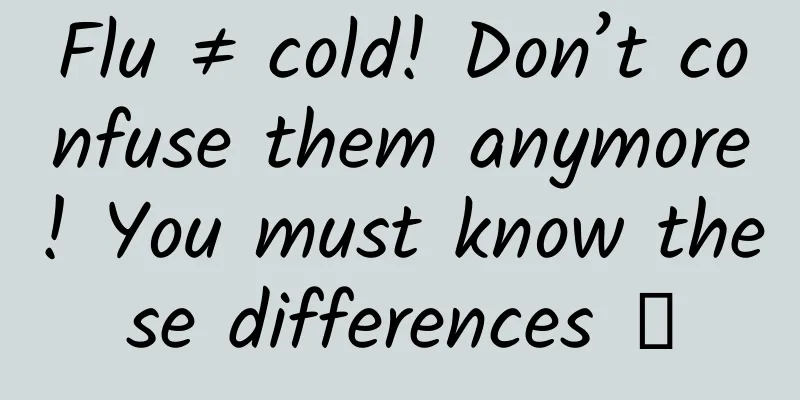Flu ≠ cold! Don’t confuse them anymore! You must know these differences →

|
Although medicine has made great progress in the past few decades, colds are still a major problem affecting human health worldwide. In the United States, about 25 million people visit their family doctors each year for uncomplicated upper respiratory tract infections, and severe syndromes caused by colds cause people to miss work and school, resulting in about 20 million days of absence from work and 22 million days of absence from school throughout the year. However, in fact, the common cold we call in daily life is not a single disease, but a general term for a series of upper respiratory tract infections caused by multiple pathogens. Even with the development of medicine, about 20% to 30% of cold cases, even when the patient recovers, it is still unclear what virus caused it. In the past half month, influenza has become a hot topic, and many people have upper respiratory tract symptoms. The National Health Commission stated at a press conference held on January 12, 2025 that the recent influenza season is relatively high, but it has not exceeded the level of the previous year's epidemic season. The number of patients in fever clinics and emergency departments across the country has shown a certain degree of upward trend, but is generally lower than the same period last year, and there is no obvious shortage of medical resources. Is there a contradiction here? Why do I feel that the people around me have more colds and fevers, and the positive rate of influenza tests is higher, but it has not exceeded the average level of previous years? To answer this question, we need to understand the differences and connections between influenza and colds. I hope that this popular science article can help everyone prevent and deal with these common diseases more effectively, reduce unnecessary medical burdens, and reduce health risks. Why is it important to know the difference between the flu and a cold? Influenza is called influenza in Chinese. Since it contains the word "cold", many people think that cold is the abbreviation of influenza. But if you look at the English names of the two, you can see the huge difference between the two. In English, a cold is called common cold, which means common cold. But influenza, the English name of influenza, is influenza, which originated from Italy. In 1658, a "plague" broke out on the Italian peninsula, killing as many as 60,000 people overnight. People were panicked and thought it was a punishment from God or a disaster caused by the movement of the planets. In Italian, influenza means devil, so people also use the word influenza to describe this devil-like disease. This word was later retained and was used in English to describe influenza, abbreviated as flu. From the original texts of these two diseases, we can see that the biggest difference between the two diseases lies in their severity. The biggest significance of distinguishing the difference between the two is: better for people and better for society . Taking influenza lightly may cause high-risk groups to neglect vaccination or timely use of antiviral drugs, leading to serious and irreversible consequences. For example, neglecting vaccination can cause influenza to cause serious complex diseases and lead to death in children; for the elderly, this problem may be more hidden, but in clinical practice, we can often see that a seemingly common cold can cause the elderly's physical condition to deteriorate rapidly, or even be unable to recover. On the other hand, if we take the common cold too seriously , it will also cause considerable problems. This situation may not only lead to a waste of medical resources, but may also cause a run on medical resources. From a personal perspective, the common cold, which could have healed on its own, increases the risk of cross-infection and even multiple infections due to blind medical treatment. From a social perspective, limited medical transport capacity may be over-occupied, resulting in people who really need timely treatment not being able to get effective help. Therefore, scientifically distinguishing between influenza and colds can not only effectively protect high-risk groups, but also rationally allocate medical resources, reduce the double burden on individuals and society, and maintain the overall health level. Copyright images in the gallery. Reprinting and using them may lead to copyright disputes. What is the relationship between flu and colds? The relationship between influenza and colds is inclusive. Our understanding of the causes of colds comes mainly from a large number of family and community follow-up studies from the 1960s to the 1980s. Prior to this, people had very limited knowledge of respiratory diseases. With in-depth research from the 1950s to the 1960s, scientists gradually discovered a variety of viruses associated with colds, such as adenovirus, parainfluenza virus, rhinovirus, respiratory syncytial virus (RSV), enterovirus, and coronavirus. These viruses can cause respiratory symptoms, and the symptoms are similar, with nasal congestion, runny nose, cough, sputum, and fever as the main manifestations. Therefore, they together constitute a disease - the common cold. Rather than saying that the common cold is a disease, it is better to say that the common cold is a group of symptoms. However, since the detection technology at that time was relatively backward and mainly relied on virus isolation methods, many viruses were difficult to detect. Therefore, at that time, only about 25% of patients with respiratory infections could confirm the specific viral cause. In recent years, with the continuous advancement of detection technology, especially the popularization of molecular detection technology such as PCR, the detection rate of viruses in clinical samples has greatly increased, allowing us to find that the pathogens that originally caused the common cold, and their proportions are as follows: Image: Main causes of colds (reference 3) From the above picture, we can see that the familiar influenza, coronavirus and the recently popular hemi-pneumovirus are all major causes of colds. Infection with influenza virus can cause a series of cold symptoms, but the development and direction of the disease are different for different viruses. How to quickly determine whether you have the flu or a cold? As mentioned above, since these two concepts are actually inclusive, distinguishing them based on symptoms is sometimes not very accurate. The fastest and most accurate method is of course pathogen detection. In clinical practice, if you must identify which virus causes a cold, the methods include virus culture, antigen detection, and PCR. However, if there is no way to conduct timely testing, then as the disease progresses, there may still be some differences in symptoms: Of course, in addition to the difference in symptoms, the biggest difference is actually the probability of disease progression, that is, the different probabilities of serious consequences. Influenza has two characteristics: first, it is more likely to cause lower respiratory tract infection than rhinovirus, adenovirus, etc.; second, it may cause a stronger immune response in the body than rhinovirus, etc. Therefore, high-risk groups (such as the elderly, infants, pregnant women and patients with chronic diseases) may develop serious complications such as pneumonia, acute respiratory distress syndrome (ARDS), myocarditis or multiple organ failure. Globally, influenza causes a large number of hospitalizations and deaths each year, and is a serious public health problem. As we have mentioned before, even healthy adults may experience severe pain after influenza infection, and the resulting temporary loss of labor or reduced quality of life is more severe than that of rhinovirus. Treatment and prevention Colds caused by different viruses naturally have different focuses in treatment: 1. Regardless of the pathogen, the initial symptoms in the short term after infection are usually similar, such as fever, nasal congestion, runny nose, etc. Regardless of the pathogen, we can treat it symptomatically. Ibuprofen and acetaminophen are safe and effective for most patients over 6 months old. If you are dealing with nasal congestion and runny nose, you can try to use nasal washing to clear nasal secretions to improve it. If bacterial sinusitis occurs, you need to see a doctor in person to determine whether antibiotics are needed to control the infection based on the condition. Coughs generally do not require special treatment. When the virus is slowly cleared, it will naturally get better. 2. Most types of colds heal on their own, but for viruses like influenza that can cause clear and serious consequences, oseltamivir and mabaloxavir are now available. However, it should be noted that whether to use medication should be decided by a doctor based on different ages and physical conditions. It is not recommended to take medication blindly. Viruses that cause upper respiratory tract infections can be spread by three main mechanisms: 1. Hand contact with secretions containing viruses, which can come directly from infected people or indirectly from environmental surfaces; 2. Small aerosol particles stay in the air for a long time; 3. Direct contact with large-particle aerosols from infected people. It can be seen that colds are difficult to prevent and control, but the good news is that we can avoid the serious effects of serious pathogens through vaccination. Influenza is a particularly good example. Summarize Although influenza and colds have similar symptoms, they are fundamentally different in their causes, severity, and outcomes. Influenza can be very harmful and can easily lead to serious complications, which is particularly fatal to high-risk groups, so vaccination and timely treatment are important; while common colds have milder symptoms and can heal on their own in most cases. References [1]Gonzales R, Malone DC, Maselli JH, et al. Excessive antibiotic use for acute respiratory infections in the United States[J]. Clinical infectious diseases, 2001, 33(6): 757-762. [2]Adams PF, Hendershot GE, Marano M A. Current estimates from the national health interview survey, 1996[J]. 1999. [3]Heikkinen T, Järvinen A. The common cold[J]. The Lancet, 2003, 361(9351): 51-59. [4] He Quanying. What is the original meaning of Influenza? [J]. Chinese Journal of Health Management, 2015, 9(2): 139-139. Planning and production Author: Chen Mo'ao, popular science author Reviewer: Li Dongzeng, Chief Physician, Department of Respiratory and Infectious Diseases, Beijing Youan Hospital Planning丨Lin Lin Editor: Zhong Yanping Proofread by Xu Lailinlin |
Recommend
Electric Technology Car News: BYD's new car M5 debuts. When will the infighting independent MPVs be able to target joint ventures?
In China, MPVs used to be business models, and we...
This year, the sentiments of Japanese anime fans can actually earn 500 million box office. What about next year?
Except for the theatrical version of Detective Co...
How do operators follow hot spots? Share 4 points!
Today I will mainly share my experience and opera...
In order to "put more 'Chinese oil' in the oil bottle", she "grinded" for 10 years
Source: Xinhua Daily Telegraph report, March 7 Au...
QQ has a new BUG, your password becomes "123456789"?
I believe that serious and studious friends shou...
Your mobile phone data may be hidden in the western region of our country! ! ! | Great Power Technology Fan
Cloud computing, big data, 5G, artificial intelli...
It's hard to say no to new energy vehicles for long-distance travel! Baidu Maps' new energy navigation leads to a convenient charging experience
In recent years, new energy vehicles have become ...
Let's have a barbecue on May Day. Let's take a look at some interesting facts about barbecue.
As the weather warms up The barbecue industry is ...
Attention, friends who ride electric bicycles! This "cold-proof magic weapon" is very dangerous →
As winter approaches, the weather is getting cold...
The jokes will make you understand what Internet thinking, big data, O2O, crowdfunding, red ocean and blue ocean are in seconds!
[[145188]] What is big data? The phone rang at a ...
Analysis of Mixue Bingcheng’s marketing plan!
Some time ago, the popularity of Mixue Bingcheng ...
Learn visual language with Hollywood animation masters 2020 [average image quality]
Learn visual language with Hollywood animation ma...
iOS 13: More system apps and components written in Swift
Apple released the new Swift programming language...
Is it useful to buy dou+ for a new Douyin account? Douyin dou+ delivery skills
Now many friends have registered accounts on Douy...
It looks beautiful but is actually dangerous. How was the name of the new coronavirus created?
Delta has not yet left, and a new variant of the ...









